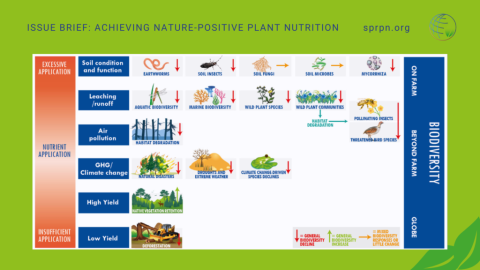Mineral nutrition, particularly the application of nutrients like nitrogen and phosphorus, plays a crucial role in agricultural crops and pastures. While optimal nutrient management is essential for food security and nutrition, both excessive or insufficient fertilizer use can have great effects on biodiversity and our natural systems.
The Complex Relationship Between Food, Biodiversity, And Nutrients
The relationship between food production, biodiversity, and nutrients is intricate and multifaceted. On one hand, the increased use of fertilizers has significantly boosted food production, ensuring food security for billions of people worldwide. On the other hand, this intensification has significantly impacted the environment and thus also biodiversity.
Biodiversity and ecosystem services are influenced by various threats, including habitat loss, climate change, and pollution. This is why we need to find a balanced and sustainable approach to nutrient management in agriculture.
Balancing Nutrient Management And Biodiversity Conservation
The key for a more nature-positive plant nutrition lies in optimizing nutrient management while securing biodiversity. To achieve this goal, scientists, policymakers, farmers, and consumers need to collaborate and adopt context-specific solutions to maintain biodiversity across different scales, from individual farms to entire landscapes.
We suggest to implement the following interventions to address the impact of nutrient management on biodiversity:
- Better land use planning, avoiding agriculture in areas with high biodiversity value and halting expansion of the agriculturally used land area
- Closing yield gaps globally to produce enough food on the existing agricultural land.
- Restoring degraded agricultural land and improving soil health and function through integrated soil fertility management
- Avoiding nutrient losses by adopting precision farming approaches for nutrient stewardship at scale
- Implementing buffer zones around environmentally sensitive areas such as waterways
- Context-specific targets for nutrient use efficiency and limits on nutrient surpluses, including better monitoring and early warning systems
- Evidence-based policies, financial incentives, and outreach to support producers and businesses to transition to more biodiversity-optimized and sustainable farming approaches
Cropland expansion and intensification should be minimal in regions with high endemism richness – the red zones.
Collaborative Actions For Nature-Positive Nutrient Management
Based on the above-outlined interventions, we agree that achieving nature-positive plant nutrition requires a collective effort from various stakeholders:
- Policymakers must utilize scientific evidence and engage with experts in agriculture, conservation, and the fertilizer industry to develop effective policies.
- Collaboration between the fertilizer industry and conservation scientists can help develop environmentally friendly fertilizer products and nutrient stewardship approaches.
- Conservation organizations should focus on identifying areas of high biodiversity value and vulnerability, develop management options, and work with governments and industries to implement sustainable practices.
- Farmers should be stewards on natural resources and grow biodiversity-friendly farming products.
- Consumers can support sustainability by purchasing products from biodiversity-friendly farming practices.
- Researchers must fill knowledge gaps around nutrient management and biodiversity, while social scientists can help identify socioeconomic and behavioral barriers to adopting sustainable practices.
Ensuring Nature-Positive Nutrient Management
Upon fulfilment of these action strategies, we see nature-positive plant nutrition based on these outcomes:
- Food production meets multiple objectives; nutrient management is optimized to close yield and efficiency gaps, provides better nutrition, and meets biodiversity objectives
- No further conversion of natural ecosystems is needed; biodiversity hotspots are managed through improved land use planning, including proactive legislation and incentives
- Biodiversity requirements are included in nutrient stewardship solutions that are scalable and adaptable to different farming systems
- Demonstrable improvements in on-farm and off-farm biodiversity and ecosystem services associated with nutrient use in agriculture
- Reduced pre-farm and on-farm greenhouse gas emissions associated with fertilizer production and use lower global climate change impacts on biodiversity
- Critical knowledge gaps are filled through research, while evidence is incorporated into legislative action that objectively addresses farming and biodiversity objectives
Yet, we are aware that to achieve these objectives, it is crucial to set context-specific and outcome-focused targets that balance nutrient use efficiency with biodiversity preservation.
Preserving Biodiversity And Ensuring Sustainable Food Production
Addressing the complex interplay between nutrient management and biodiversity conservation requires a holistic and collaborative approach. Through sustainable intensification, optimized nutrient stewardship, improved land use planning, and incorporated biodiversity considerations into all levels of decision-making, we can achieve nature-positive plant nutrition.
By working together, we can secure food production while protecting the delicate ecosystems that sustain life on our planet. It is only through collective action that we can meet the challenges of our time and preserve biodiversity for future generations.


